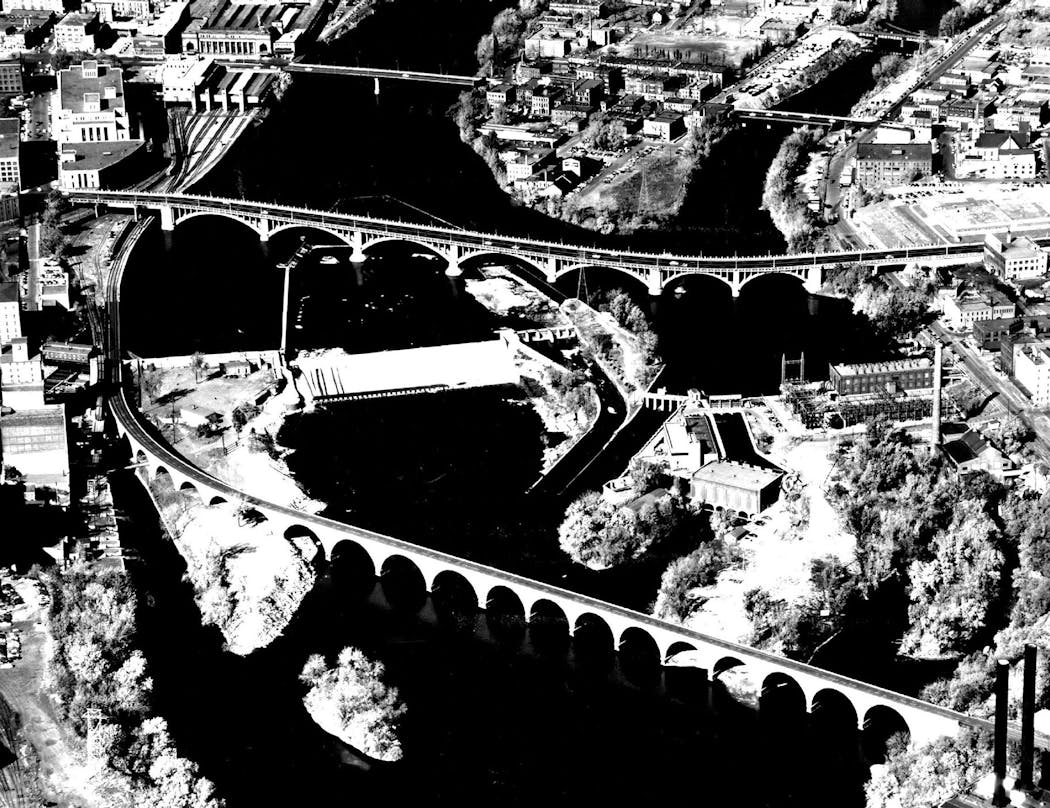Why does the Stone Arch Bridge cross the river at such an odd angle?
Minneapolis was a tiny burg when the Stone Arch Bridge brought striking grandeur and elegance to the city's industrial riverfront. Even surrounded by a modern day metropolis, the bridge remains one of the region's most eye-catching landmarks.
Older than most historic buildings still standing in the Twin Cities, the 136-year-old bridge has long been Minneapolis' de facto welcome mat. Before it was a hot spot for sightseeing and wedding photos, railroad passengers peered from their windows down at St. Anthony Falls as their trains followed the bridge's gentle curve into downtown.
That bridge's diagonal orientation — one of its most distinct features — was on the mind of a Star Tribune reader who wanted to know why the bridge cuts across the Mississippi River at such a peculiar angle. The reader submitted the question to Curious Minnesota, our community-driven reporting project fueled by questions from inquisitive readers.
The answer has more to do with logistics than aesthetics.
Minneapolis had a railroad problem in the 1880s. Apart from a rickety suspension bridge, there was no efficient method of bringing goods and passengers into downtown Minneapolis from key rail tracks on the east side of the river. So city leaders called upon James J. Hill, who owned the main rail connection between Minneapolis and St. Paul, to develop a solution.
Their goal was to eventually bring trains into a Union Depot that would be erected near what was then the heart of the city, known as Bridge Square, at the intersection of Nicollet and Hennepin avenues. Hill initially considered taking a more direct route there with a new bridge across Nicollet Island, according to "Hill's Folly," an authoritative 1987 history of the bridge published in Hennepin History Magazine.
But his engineer, Col. Charles C. Smith, was wary of disrupting the sandstone riverbed above the falls — which was already eroding — and perhaps fundamentally altering the water power fueling the city's industry. A catastrophic collapse caused by the construction of a tunnel a dozen years earlier was still fresh in people's minds. They were also worried about the bridge's pillars creating ice and logjams above the falls, according to the 1987 history.
Instead they decided to play it safe and build the bridge below the falls, just upstream from where Hill's tracks ended (near modern day Dinkytown). It would cross at a diagonal — with a six-degree curve at one end — so trains could easily travel into the riverside rail yards on their way to and from the proposed depot.
Speed was an important factor. Most railroad bridges of the day were fragile timber structures that trains had to traverse slowly, said Ray Lowry, a Worthington history teacher who wrote the "Hill's Folly" article. (The title references what critics labeled the bridge when it was built.)
"Hill didn't want that," Lowry said. "He wanted something that was permanent, something that those trains could steam over at full speed."
In 1881, a Minneapolis Tribune reporter asked Smith why they were building a Stone Arch Bridge, rather than one constructed of iron.
"Because stone arch bridges never fall down or burn up and trains can be run as fast on them as on the ground," Smith replied.
When the bridge opened in 1883, the Tribune said it would reduce the travel time to St. Paul by 10 minutes.
"[I]t is constructed to stand the test of time until the golden age shall arrive when the problem of aerial navigation shall have been solved, and railroads and railroad bridges will be useless works of engineering," the paper reported
An added benefit of the design was that it created a great vantage point for viewing the falls — as modern day sightseers can attest. But David Wiggins, an expert in the city's riverfront history, said that likely wasn't a part of Hill's consideration.
"I think the main concern was, 'Here's the geography and how the lines have to connect up together,' " Wiggins said. "It's a side benefit everybody began to recognize early on, though, was this was a great way to show off the city."
The depot opened in 1885 and soon most of the major railroads were crossing the new bridge and shuttling people to and from the new facility. It became so popular that a new depot was required, prompting the construction of the Great Northern Depot in 1914, according to Lowry's history. That building was demolished in 1978.
---
If you'd like to submit a Curious Minnesota question, fill out the form below:
Read more Curious Minnesota stories:
Why are Honeycrisp apples still so expensive?
Why is it so much harder for U students to graduate debt free compared with the 1960s?
How did Minnesota become one of the most racially inequitable states?
What is the best place, time to see northern lights in Minnesota?
Why does everyone love to hate Edina?
Sorry, but why do Minnesotans say 'ope' all the time?
How did these 11 Minnesota towns get their unusual names?
How did the Twin Cities become a hub for Somali immigrants?




